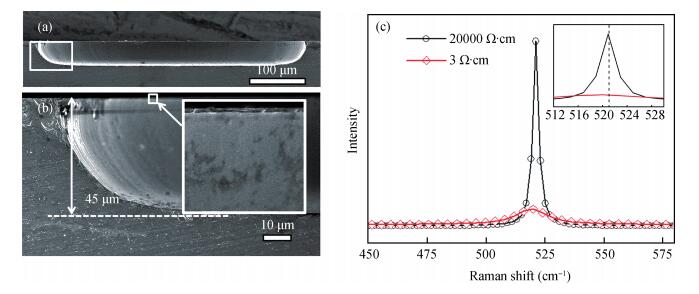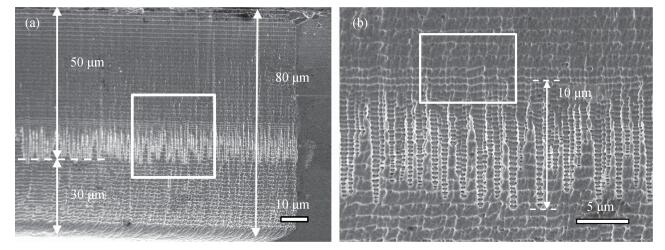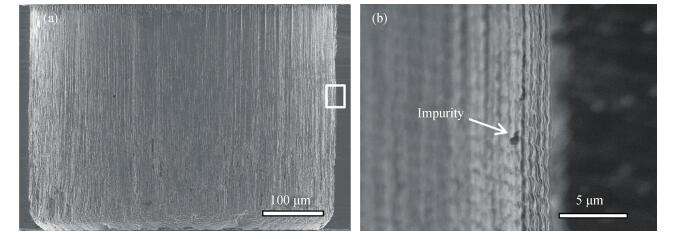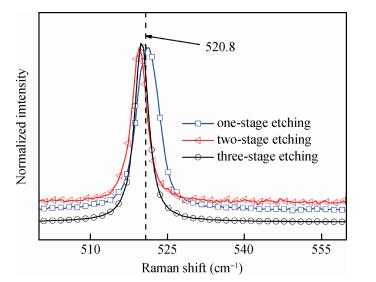| Citation: |
Lin Du, Shengrui Xu, Ying Wang, ling Lü, Jincheng Zhang, Yue Hao. Investigation of etching method for fabricating deep through holes on ultra-highresistivity silicon[J]. Journal of Semiconductors, 2017, 38(5): 056002. doi: 10.1088/1674-4926/38/5/056002
****
L Du, S R Xu, Y Wang, L Lü, J C Zhang, Y Hao. Investigation of etching method for fabricating deep through holes on ultra-highresistivity silicon[J]. J. Semicond., 2017, 38(5): 056002. doi: 10.1088/1674-4926/38/5/056002.
|
Investigation of etching method for fabricating deep through holes on ultra-highresistivity silicon
DOI: 10.1088/1674-4926/38/5/056002
More Information
-
Abstract
In this paper, the etching characteristics of the ultra-high resistivity silicon (UHRS) by using the Bosch process were investigated. The experimental results indicated that the sulfur hexafluoride flux, the temperature of the substrate, the platen power and the etching intermittence had important influence on the etching rate and the etching morphology of the UHRS. The profiles and morphologies of sidewall were characterized with scanning electron microscopy (SEM). By using an improved three-stage Bosch process, 380-μm deep through holes were fabricated on the UHRS with the average etching rate of about 3.14 μm/min. Meanwhile, the fabrication mechanism of deep through holes on the UHRS by using the three-stage Bosch process was illustrated on the basis of the experimental results. -
References
[1] Li R, Jin C, Ong S C, et al. Embedded wafer level packaging for 77-GHz automotive radar front-end with through silicon via and its 3-D integration. IEEE Trans Compon, Packag Manufact Technol, 2013, 3: 1481 doi: 10.1109/TCPMT.2012.2236385[2] Lincelles J B, Marcelot O, Magnan P, et al. Enhanced nearinfrared response CMOS image sensors using high-resistivity substrate: photodiodes design impact on performances. IEEE Trans Electron Devices, 2016, 63: 120 doi: 10.1109/TED.2015.2477897[3] Chahat N, Tang A, Lee C, et al. Efficient CMOS systems with beam-lead interconnects for space instruments. IEEE Trans Terahertz Sci Technol, 2015, 5: 637 doi: 10.1109/TTHZ.2015.2446200[4] Ok S J, Kim C, Baldwin D F. High density, high aspect ratio through-wafer electrical interconnect vias for MEMS packaging. IEEE Trans Adv Packag, 2003, 26: 302 doi: 10.1109/TADVP.2003.818060[5] Fischer A C, Bleiker S J, Haraldsson T, et al. Very high aspect ratio through-silicon vias (TSVs) fabricated using automated magnetic assembly of nickel wires. J Micromechan Microeng, 2012, 22: 105001 doi: 10.1088/0960-1317/22/10/105001[6] Ma X Z, Zhang R, Sun J B, et al. Reduction of reactive-ion etching-induced Ge surface roughness by SF6/CF4 cyclic etching for Ge Fin fabrication. Chin Phys Lett, 2015: 69 https://www.researchgate.net/publication/287504779_Reduction_of_RIE_induced_Ge_surface_roughness_by_SF6-CF4_cyclic_etching_method[7] Ren Z, McNie M E. Inductively coupled plasma etching of tapered via in silicon for MEMS integration. Microelectron Eng, 2015, 141: 261 doi: 10.1016/j.mee.2015.03.071[8] Jo S B, Lee M W, Lee S G, et al. Characterization of a modified Bosch-type process for silicon mold fabrication. J Vac Sci Technol A, 2005, 23: 905 doi: 10.1116/1.1943467[9] Li R, Lamy Y, Besling W F A, et al. Continuous deep reactive ion etching of tapered via holes for three-dimensional integration. J Micromechan Microeng, 2008, 18: 125023 doi: 10.1088/0960-1317/18/12/125023[10] Lee Y H, Chen M M. Silicon doping effects in reactive plasma etching. J Vac Sci Technol B, 1986, 4: 468 doi: 10.1116/1.583405[11] Bleiker S J, Fischer A C, Shah U, et al. High-aspect-ratio through silicon vias for high-frequency application fabricated by magnetic assembly of gold-coated nickel wires. IEEE Trans Compon, Packag Manufact Technol, 2015, 5: 21 doi: 10.1109/TCPMT.2014.2369236[12] Wu B Q, Kumar A, Pamarthy S. High aspect ratio silicon etch: a review. J Appl Phys, 2010, 108: 051101 doi: 10.1063/1.3474652[13] Bates R L, Thamban P L S, Goeckner M J, et al. Silicon etch using SF6/C4F8/Ar gas mixtures. J Vac Sci Technol A, 2014, 32: 041302 doi: 10.1116/1.4880800[14] Li C T, Hsieh F C, Wang L. Performance improvement of p-type silicon solar cells with thin silicon films deposited by low pressure chemical vapor deposition method. Sol Energy, 2013, 88: 104 doi: 10.1016/j.solener.2012.12.001[15] Smit C, Van Swaaij R A C M M, Donker H, et al. Determining the material structure of microcrystalline silicon from Raman spectra. J Appl Phys, 2003, 94: 3582 doi: 10.1063/1.1596364[16] Gogolides E, Boukouras C, Kokkoris G, et al. Si etching in highdensity SF 6 plasmas for microfabrication: surface roughness formation. Microelectron Eng, 2004, 73: 312 http://www.academia.edu/8555781/Si_etching_in_high-density_SF_6_plasmas_for_microfabrication_surface_roughness_formation[17] Pessoa R S, Maciel H S, Petraconi G, et al. Effect of gas residence time on the morphology of silicon surface etched in SF 6 plasmas. Appl Surf Sci, 2008, 255: 749 doi: 10.1016/j.apsusc.2008.07.057[18] Waits C M, Morgan B, Kastantin M, et al. Microfabrication of 3D silicon MEMS structures using gray-scale lithography and deep reactive ion etching. Sens Actuators A, 2005, 119: 245 doi: 10.1016/S0924-4247(04)00193-1[19] Lai S L, Johnson D, Westerman R. Aspect ratio dependent etching lag reduction in deep silicon etch processes. J Vac Sci Technol A, 2006, 24: 1283 https://www.researchgate.net/publication/237964989_Aspect_ratio_dependent_etching_lag_reduction_in_deep_silicon_etch_processes[20] Lill T, Grimbergen M, Mui D. In situ measurement of aspect ratio dependent etch rates of polysilicon in an inductively coupled fluorine plasma. J Vac Sci Technol B, 2001, 19: 2123 doi: 10.1116/1.1415514[21] Chang C, Wang Y F, Kanamori Y, et al. Etching submicrometer trenches by using the Bosch process and its application to the fabrication of antireflection structures. J Micromechan Microeng, 2005, 15: 580 doi: 10.1088/0960-1317/15/3/020[22] Lee H C, Hong S P, Kang S K, et al. Residual stress on nanocrystalline silicon thin films deposited under energetic ion bombardment by using internal ICP-CVD. Thin Solid Films, 2009, 517: 4100 doi: 10.1016/j.tsf.2009.01.140 -
Proportional views






 DownLoad:
DownLoad:


















